Posted by Elena del Valle on August 11, 2010
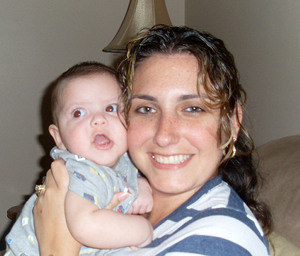
Photos: Babyspot.com, Todobebe.com
Our nation’s birth rate has declined in the past 20 years. During that time period new mothers have become more likely to be older, better educated and less likely to be white. Fewer white women are having babies while an increasing number of babies are born of Hispanic moms, according to a recently released report. One in four births in 2008 was to a Hispanic mother. Although white women still represented more than half of mothers of newborns that year that was less than the 65 percent of white women who gave birth in 1990.
More than half of mothers of newborns in 2006 had spent some time in college which was an improvement over the 41 percent of women who had some college education in 1990. Older mothers of newborns, those 35 years of age and older, were much more likely to have some college education (71 percent).

James Rivera, co-founder, Babyspot
“I do see evidence of your findings, our site agrees with most of your data. Our traffic has increased in the last year, it’s around 30 percent increase,” said James Rivera, co-founder and chief executive officer, BabySpot, Inc. when asked if he sees evidence of these trends.
Women are also waiting longer to have babies than they did twenty years ago. While in 1990, teenagers had a higher share of all births (13 percent) than did women 35 years of age and older (9 percent) by 2008, the reverse was true with 10 percent of births to teens and 14 percent to women ages 35 and older. This increase in older mothers held across ethnic groups.
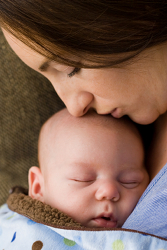
More unmarried women by far (41 percent) had babies in 2008 than in 1990 (28 percent). Black unmarried women were the most likely to have babies compared white and Hispanics.
“There are 4M (million) births per year and 1M (million) are to Spanish speaking parents, 25 percent of the newborns. This has been a constant for the past two years and is based on U.S. Census Live Birth Statistics,” said Cynthia Nelson of Todobebe.com. “We have a 20 percent increase in moms that join Todobebe in the past year and about 55 percent of our moms are pregnant at any one give time. There is no one month during the year that there are more births with the exception of the slight increase in September (December holidays trigger this event).”
In 2008, there were 4.3 million births in our country slightly more than in 1990 when there were 4.2 million. Between 2003 to 2007 the number of births increased each year and then declined by about 66,000; the researchers believe the decrease is the result of the economic downturn.
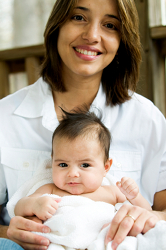
Immigrants tend to have higher birth rates than the native born although those rates have declined in recent years. The share of births to foreign-born mothers, 15 percent of U.S. births in 1990, grew 60 percent through 2004. In 2004, births to foreign-born women represented the majority of Hispanic (61 percent) and Asian (83 percent) births.
Although it is hard to think about our nation’s demographic profile in 40 years, according to Pew Research Center population projections and assuming current trends remain steady, 82 percent of the nation’s population growth through 2050 will be produced by immigrants who arrived in our country after 2005 and their descendants. The researchers estimate 142 more million people will fuel our population between 2005 and 2050; of these 50 million will be the children and grandchildren of new immigrants.
The report, The New Demography of American Motherhood, was written by Gretchen Livingston and D’Vera Cohn of the Pew Research Center based on data from the National Center for Health Statistics and the Census Bureau. It also included the findings of a national Pew Research Center survey about parenthood.
Posted by Elena del Valle on July 28, 2010
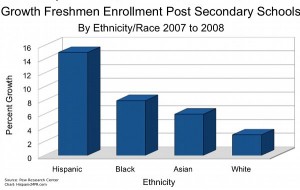
Freshmen Enrollment Growth by Ethnicity/Race – click to enlarge
What are young people in America to do during this recession? Enroll in college. There is a college boom taking place and it is being driven by minorities, according to a recent Pew Research Center
article based on the organization’s analysis of new data from the United States Department of Education.
There was an increase of 144,000 freshman students from the fall of 2007 to the fall of 2008, the first year of the recession, at the nation’s 6,100 post-secondary institutions representing a 6 percent increase, the largest in 40 years. Almost three-quarters of the growth was from minority freshmen.
From 2007 to 2008 although there was only a 3 percent increase in freshman college enrollment of whites, minority enrollment was noteworthy. Hispanics enrollment at post secondary institutions grew 15 percent, blacks enrollment grew 8 percent, and Asian enrollment grew 6 percent.
Of course the growth is not spread evenly across the country. Cities with historically large ethnic, especially Hispanic, populations may have markedly higher increases and an overall higher ethnic presence. An example is South Florida.
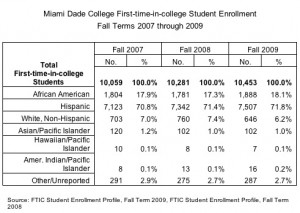
Click on image to enlarge
“MDC’s enrollment growth reflects the community we serve: more than 80 percent of Miami-Dade’s residents are racial or ethnic minorities, with Hispanics predominating. In the 2000 Census 57 percent of Miami-Dade County residents were Hispanic, increasing to 62 percent in the latest estimates. Hispanics at MDC have increased steadily as a proportion of overall student enrollment from 2007 through 2009, and even more so as a percentage of freshman enrollment,” said Margaret Mannchen, associate director, Institutional Research Operations, Miami Dade College, one of the largest post-secondary institutions in the country in both number of students enrolled (170,000) and number of associates degrees awarded
“Now Hispanics are about 72 percent of our first-time-in-college students. Looking at all credit students, we see both African American and White Non-Hispanic percentages declining slightly from Fall 2007 through Fall 2009. In 2009, however, the proportion of African American freshmen was starting to show an increase, after a slight decline in 2008.”
The growth is not surprising given the demographic profile of the United States. As the white population ages it is the minority youth that fuel the nation’s growth. In addition, Census Bureau surveys indicate the Hispanic high school completion rate reached an all-time high of 70 percent in October 2008, a 2.5 percent increase over 2007 and the largest increase of any ethnic or racial group.
Although in the past minority students tended to seek community colleges and trade schools, the growth from 2007 to 2008 was at all basic levels of post secondary education. At the same time, a lower percent of white freshmen enrolled in less-than-four-year schools in 2008 (53 percent) than in 2007 (55 percent); and in four-year schools in 2008 (62 percent) than in 2007 (64 percent).
Of course not all institutions of higher learning showed an increase for that time period. One private university in South Florida had a decrease in enrollment numbers.
“Unfortunately I don’t know that 2008 would be a good bench as nationally there was a decrease in overall enrollment due to the financial crisis and the availability of credit. The numbers picked up again sharply for 2009 and we are currently tracking for 2010 at about a 2-3% increase in enrollment. As I look at the applications coming in we are definitely seeing an increase in minority applications and matriculations,” said Andre Lightbourn, dean, Enrollment Management, Saint Thomas University in Broward County.
“According to our institutional fact book amongst the broad categories Black and Hispanic we are probably about flat for 2007, 2008 & 2009. The numbers have increased for foreigners and other ethnic groups. The number of white students has declined in the same period for the last three academic years 2007, 2008 & 2009.”
An executive summary of the Pew Research Center analysis, written by Richard Fry, was published June 16, 2010. The Pew Research Center, a self described nonpartisan provider of information on “the issues, attitudes and trends shaping America and the world.”
Posted by Elena del Valle on July 21, 2010
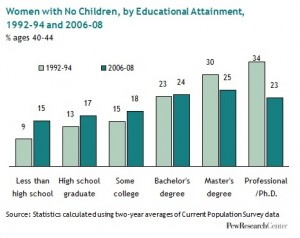
Childless women by educational level – click to enlarge
Graphs: Pew Research Center
In the United States, white women are among all ethnic and racial groups the most likely not to have had a child over the past decade. Over that time period the gap between groups has narrowed with childless rates rising more rapidly for black, Hispanic and Asian women, than for white women. Not surprisingly, women who have never married are most likely to be childless. At the same time, those rates have declined over the past decade and the rate of childlessness has risen for married women and women who were married at one time, according to a recent report from the Pew Research Center.
In 2008, 20 percent or one in every five white women between 40 and 44 years of age was childless. That same year, 17 percent of black and Hispanic women and 16 percent of Asian women in that age group were also without children. Between 1994 and 2008, the rates of childlessness increased more for nonwhites than for whites: the childlessness rates for black women and for Hispanic women went up by more than 30 percent while the increase among white women was 11 percent.
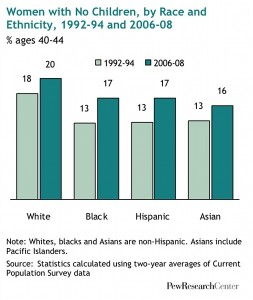
Childless women by race/ethnicity – click to enlarge
This is a sharp contrast to the rates in the 1970s when only 10 percent of white women reached the end of their childbearing years without ever becoming a mother. Although the most educated women are the most likely never to give birth to a child, the exception to the childlessness rates increase was among women with advanced university degrees where the rate fell in the past 10 years. In 2008, 24 percent of women ages 40 to 44 with a master’s, doctoral or professional degree had not had children, a decline from 31 percent in 1994.
The researchers believe childlessness increased for several reasons. Women today endure less social pressure to have children than in past decades. Improved contraceptive methods and better job options for women were also cited as influencing women’s decision to not have children. Women, especially educated women, have delayed marriage and having children, the researchers explain in the report.
Another factor is that some women do not give birth but raise adopted children. In 2008, there were 61.6 million biological children, 1.6 million adopted children and 2.5 million stepchildren in United States homes (2008 American Community Survey).
The report, Childlessness Up Among All Women; Down Among Women with Advanced Degrees, was written by Gretchen Livingston and D’Vera Cohn of the Pew Research Center and released June 25, 2010. They based their findings on Current Population Survey data. The Pew Research Center, a self described nonpartisan provider of information on “the issues, attitudes and trends shaping America and the world.”

















